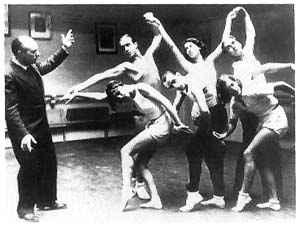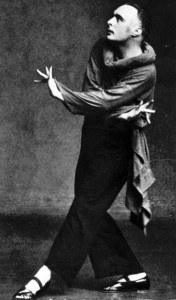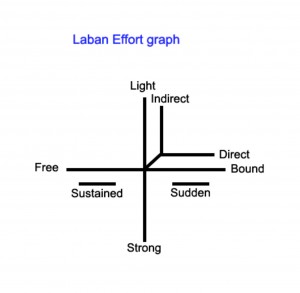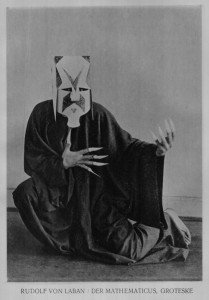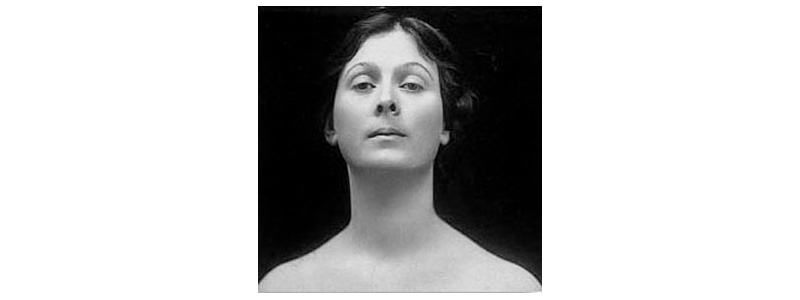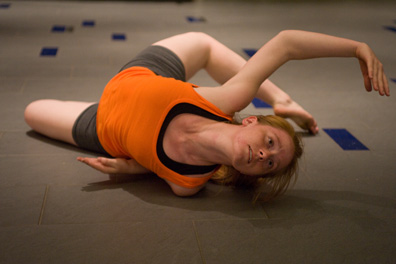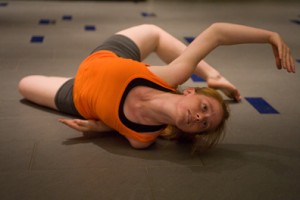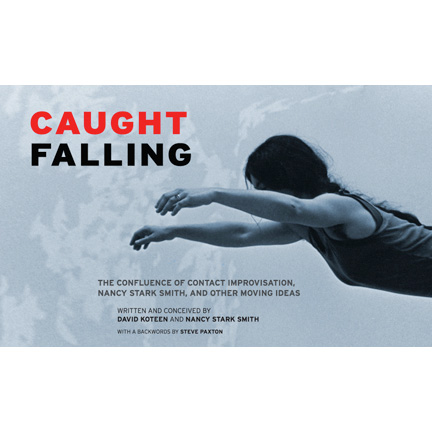Hi. David Koteen here. Recently I completed a book with and about Nancy Stark Smith, entitled Caught Falling. Many of you will know Nancy as an experienced performer and teacher of the dance form Contact Improvisation.
In Contact Improvisation there’s no leader, no follower. No hierarchy. Contact Improvisation is democratic by its nature. Just bring your best game to the floor, make a point of contact, and begin. Follow and lead. Stay connected.
Our experience participating in the development of Contact has occurred in moment after moment. Creating Falling with Nancy, we realized that there was no way to summarize years of experience. Our book contains selected episodes from our experiences together with Contact Improvisation.
Because we are both such dedicated Contacters, every step in creating this book encouraged another step. Caught Falling is our dance, 14 years in the making and hardly breathing hard.
Following is the Table of Contents with a taste or two from each section.
David Koteen 5/4/09
Table of Contents
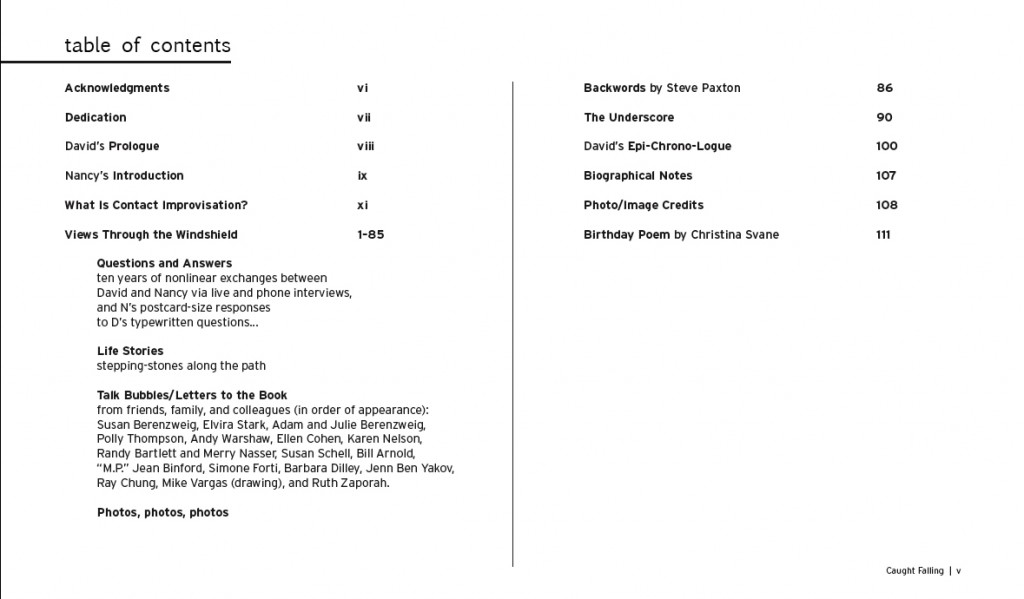
Prologue
Nancy and I have been working on this book, Caught Falling, on and off, in fits and starts, since 1994. It has truly been an engagement of two Aquarian, writer-type, Contact Improvisers. Fun, research, and exploration; very challenging, always moving. A slow long-distance dance.
Caught Falling is about Nancy’s life, about Contact Improvisation, about our mutual devotion to this endlessly delightful art-sport. We’ve generated volumes of material, edited and reedited, replaced, sought counsel, laughed at our complicated musings. How like a river the book caught us up in its current. Who knew where it would take us? What it would be?
Since the beginning of the project, my intention with Caught was to further disseminate information about CI, with Nancy as the medium: How she has unhesitatingly taken on major roles as Contact archivist, continuous editor of Contact Quarterly, initiator of CI25, and on and on. How she has wandered the globe like some peripatetic diva, embodying the spirit of Contact in her teaching, writing, performing, workshops, dance—life.
Take a look at Caught Falling; make contact with it; jam awhile…enjoy the ride!
From: What Is Contact Improvisation
Contact Improvisation (CI) is, at its root, a duet dance form based on the dialogue of weight, balance, reflex, and impulse between two moving bodies that are in physical contact. The form was first presented during a series of performances that took place in New York City in June 1972 at the John Weber Gallery, conceived and directed by American choreographer Steve Paxton.
It is a free play with balance, self-correcting the wrong moves and reinforcing the right ones, bringing forth a physical/emotional truth about a shared moment of movement that leaves the participants informed, centered, and enlivened.
When I asked Steve recently what he thought the “core proposition” of Contact Improvisation was, at first he said he didn’t know, but on further reflection he offered this: “Do under others as you would have them do under you.”
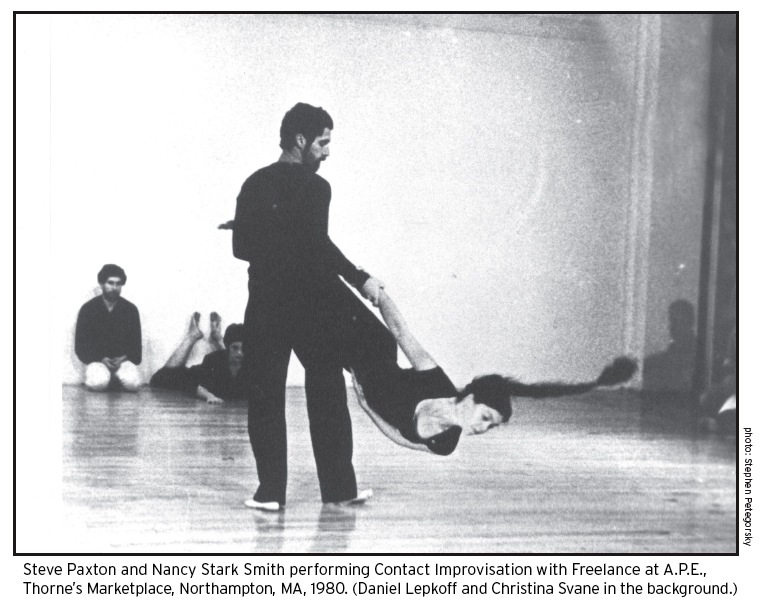
From: Epi-chrono-logue
From 1985 to 1990, prior to Raku and the falling rose incident, I had more observed Nancy from afar: teaching, laughing, singing, skipping – being best friends with her body – running backwards (eyes closed, standing by river in red beret) headstand with braid swishing like panther’s tail. Seamlessly fearless. We shared an occasional dance, lunch, happenstance, flash dialogue, random meeting. In Nancy I found a sophisticated sororal ally. An amphibious monkey creature, who like me, luxuriated in movement, romance, service and freedom.
My self had become rededicated to the principle of self-liberation through assistance to others on their respective paths…and here she was, Nancy, embracing her own karma, being her own gravity.
We shared a craving for precise language, art/icu/lation. Giving things their proper names. I suggested an interview, or intra-view, or VIEWS: our first working title.
I had been published on and off by The Sun Magazine and wrote editor Sy Safransky, January 1994, about interviewing NSS on CI for The Sun…..
From: He Made Me Do It
Caught Falling is a book for you to enter anywhere, follow along with, skip around in, imagine your own answers to the questions, be amused, be informed, enjoy in your own time. Follow the faces and the passage of time through a life; a family; an extended family of relatives, colleagues and friends. Imagine your life in it.
I have benefited beyond calculation from the profound teachings and enlivening practice of Contact Improvisation. Thank you Contact, thank you Steve, thank you David, thank you Contacters all over the world. May the benefit of our work and our pleasure in the dancing continue to multiply.
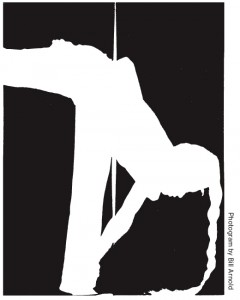 Nancy Stark Smith 2008
Nancy Stark Smith 2008
Simone Forti’s Talk Bubble
Color is light, and Nancy has an eye for color. Delicate
and precise. Deep red, pale yellow, purple black, sky
blue. A touch of juniper. I’ve often wondered what
other animals must think of us, always changing
clothes, changing colors, so they can’t say of
us “the one that hangs out by the creek; the gray
one with white marking on its breast.” But of Nancy
they can always say, “The one that gives off light,
like wild flowers clustered in a clearing.”
From: Questions and Answers
David: I often describe Contact Improvisation as an American martial art but with no defense. Comment?
Nancy: And no offense? Defense and offense are communications that probably occur in CI too. But in CI, the intention of the activity is not to fight or prevail over the other or to neutralize their aggression, but to dance together. Perhaps in CI you could call it action and reaction. Yes, like martial arts: always being in the ready state. Maybe it’s closest to tai chi “push hands” practice, where you’re testing each others readiness to respond.
David: Currently for me, intimacy is the new road, the work, the way. Intimacy and touch go hand in hand. And contrary-wise, non-intimacy and non-touch lead to abuse and bayonets. As Karen Nelson so aptly stated: “Contact is the “touch revolution.”
Nancy: In Contact Improvisation, you need to be able to harmonize with your partner physically and energetically to dance with abandon safely. To read and be read through the surface of the skin takes patience and speed. It requires being aware of yourself and the other at the same time, often sharing a common center of balance – synchronizing weight, rhythm, and timing enough to proceed. This does tend to reinforce cooperation rather than aggression. In Contact, initiative can replace aggression.
From: Steve Paxton’s Backwords
As Contact Improvisation has enlarged geographically, it has become more inclusive socially. Ballet dancers, modern dancers, postmodern dancers, folks with disabilities, and just plain folks have ventured into the swirl of it. Apparently, a new common dance has emerged.
It is difficult for me to imagine the developments of the past quarter century without feeling gratitude for the keys Nancy has provided, the doors she has opened. She has made it possible for us to know ourselves and maintained a forum for our words, which will give future dancers an idea of this period.
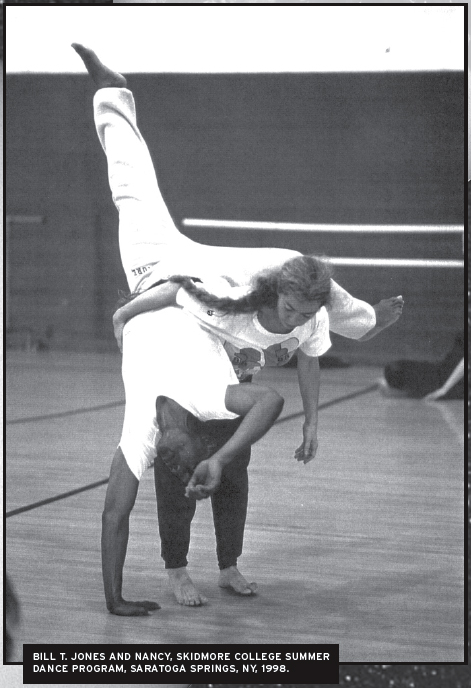 From: Life Stories
From: Life Stories
Quitting smoking
Thanks to Bill’s support, I quit smoking on January 28, 1986, which turned out to be the day that I was interviewing Bonnie Cohen and also the day the space shuttle Challenger blew up. Quitting smoking opened up a deep, raw emotional flow that I hadn’t realize was constricted; it introduced me to sadness I didn’t know I had and taught me how to tolerate my own tears. It was tremendously empowering to be able to give up a pleasurable but enslaving addiction.
From: The Underscore
What it is
The Underscore is a framework for practicing and researching dance improvisation that I’ve been developing since the early 1990’s. It is a score that guides dancers through a series of “changing states,” from solo deepening/releasing and sensitizing to gravity and support; through group circulation and interaction, Contact Improvisation (CI) engagements, opening out to full group improvisation with compositional awareness, and back to rest and reflection.
The Underscore can be seen as a vehicle for incorporating Contact Improvisation into a broader arena of improvisational practice; for creating greater ease for dancing in spherical space – alone and with others; and for integrating kinesthetic and compositional concerns while improvising. The Underscore is also being used in the CI community worldwide as a way to focus and concentrate Contact jams.
Dedications
This book is dedicated to probing life’s mysteries through movement, and to the people whose work that is.
NSS
To self-liberation & simultaneous liberation of others, which is both sides of Contact Improv.
DK
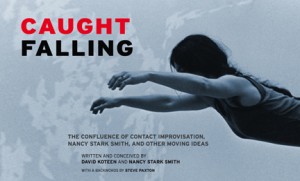
Caught Falling is distributed by:
Contact Editions
P.O. Box 603
Northampton, MA 01061
 The impact on the financial value of a copyrighted material is a central issue in settlement of Fair Use-defended law suits. Writing on his website the marketer-cum-journalist Brad Templeton reported, “Famously, copying just 300 words from Gerald Ford’s 200,000 word memoir for a magazine article was ruled as not fair use, in spite of it being very newsworthy, because it was the most important 300 words — why he pardoned Nixon.” Artists would be well-served to empower their own usage and the usage of others by considering how fair use law applies to their work.
The impact on the financial value of a copyrighted material is a central issue in settlement of Fair Use-defended law suits. Writing on his website the marketer-cum-journalist Brad Templeton reported, “Famously, copying just 300 words from Gerald Ford’s 200,000 word memoir for a magazine article was ruled as not fair use, in spite of it being very newsworthy, because it was the most important 300 words — why he pardoned Nixon.” Artists would be well-served to empower their own usage and the usage of others by considering how fair use law applies to their work. 
